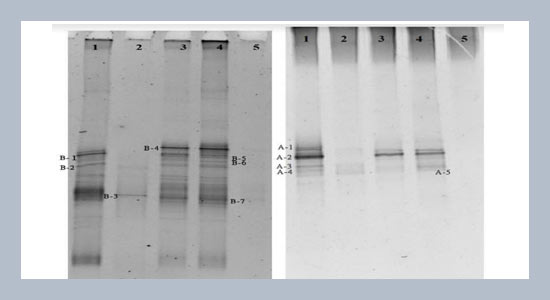REFERENCES
- [1] Vandenberg, L. N., Hauser, R., Marcus, M., Olea, N., and Welshons, W. V. 2007. Human exposure to bisphenol A (BPA). Reproductive Toxicology, 24: 139-177.
- [2] Li, X., Ying, G. G., Su, H. C., Yang, X. B., and Wang, L. 2010. Simultaneous determination and assessment of 4-nonylphenol, bisphenol A and triclosan in tap water, bottled water and baby bottles. Environment International, 36: 557-562.
- [3] Kurebayashi, H., Okudaira, K., and Ohno, Y. 2010. Specific difference of metabolic clearance of bisphenol A using cryopreserved hepatocytes fromrats, monkeys and humans. Toxicology Letters, 198: 210-215.
- [4] Korkmaz, A., Ahbab, M. A., Kolankaya, D., and Barlas, N. 2010. Influence of vitamin C on bisphenol A, nonylphenol and octylphenol induced oxidative damages in liver of male rats. Food and Chemical Toxicology, 48: 2865-2871.
- [5] Zeng, G., Zhang, C., Huang, G., Yu, J., Wang, Q., Li, J., Xi, B., and Liu, H. 2006. Adsorption behavior of bisphenol A on sediments in Xiangjiang River, Central-south China. Chemosphere, 65: 1490-1499.
- [6] Wang, C., Zhu, L., Song, C., Shan, G., and Chen, P. 2011. Chrarcterization of photocatalyst Bi3.84W0.16O6.24 and its photodegradation on bisphenol A under simulated solar light irradiation. Applied Catalysis B: Environment, 105: 229-236.
- [7] Frontistis, Z., Daskalaki, V. M., Katsaounis, A., Poulios, I., and Mantzavinos, D. 2011. Electrochemical enhancement of solar photocatalysis: degradation of endocrine disruptor bisphenol-A on Ti/TiO2 films. Water Research, 45: 2996-3004.
- [8] Tsai, W. T., Lee, M. K., Su, T. Y., and Chang, Y. M. 2009. Photodegradation of bisphenol-A in a batch TiO2 suspension reactor. Journal of Hazardous Materials, 168: 269-275.
- [9] Li, C., Li, X. Z., Graham, N., and Gao, N. Y. 2008. The aqueous degradation of bisphenol A and steroid estrogens by ferrate. Water Research, 42: 109-120.
- [10] Guo, Z. and Feng, R., 2009. Ultrasonic irradiation-induced degradation of low-concentration bisphenol A in aqueous solution. Journal of Hazardous Materials, 163: 855-860.
- [11] Tsutsumi, Y., Haneda, T., and Nishida, T. 2001. Removal of estrogenic activities of bisphenol A and nonylphenol by oxidative enzymes from lignin-degrading basidiomycetes. Chemosphere, 42: 271-276.
- [12] Kabiersch, G., Rajasärkkä, J., Ullrich, R., Tuomela, M., Hofrichter, M., Virta, M., Hatakka, A., and Steffen, K. 2011. Fate of bisphenol A during treatment with litter-decomposing fungi Stropharia rugosoannulata and Stropharia coronilla. Chemosphere, 83: 226-232.
- [13] Yamanaka, H., Moriyoshi, K., and Ohmoto, T. 2008. Eficient microbial degradation of bisphenol A in the presence of activated carbon. Journal of Biosciience and Bioengineering, 105: 157-160.
- [14] Bertanza, G., Pedrazzani, R., Grande, M.D., Papa, M., Zambarda, V., Montani, C., Steimberg, N., Mazzoleni, G., and Lorenzo, D.D. 2011. Effect of biological and chemical oxidation on the removal of estrogenic compounds (NP and BPA) from wastewater: An integrated assessment procedure. Water Research, 45: 2473-2484.
- [15] Kang, J. H., Katayama, Y., and Kondo, F. 2006. Biodegradation or metabolism of bisphenol A: From microorganisms to mammals. Toxicology, 217: 81-90.
- [16] Lo, H.M., Chiu, H.Y., Lo, S.W., and Lo, F.C. 2012. Effects of different SRT on anaerobic digestion of MSW dosed with various MSWI ashes. Bioresource Technol. Accepted.
- [17] Goh, C.S., Tan, K.T., Lee K.T., and Bhatia, S., 2010. Bio-ethanol from lignocellulose: Status, perspectives and challenges in Malaysia. Bioresource Technology, 101: 4834-4841.
- [18] Lo, H. M., Kurniawan, T. A., Sillanpää, M. E. T., Pai, T. Y., Chiang, C. F., Chao, K. P., Liu, M. H., Chuang, S. H., Banks, C. J., Wang, S. C., Lin, K. C., Lin, C. Y., Liu, W. F., Cheng, P. H., Chen, C. K., Chiu, H. Y., and Wu, H. Y., 2010. Modeling biogas production from organic fraction of MSW co-digested with MSWI ashes in anaerobic bioreactors. Bioresource Technology, 101: 6329-6335.
- [19] Lo, H.M. and Liao, Y.L. 2007. The metals-leaching and acids-neutralizing capacity of MSW incinerator ash co-disposed with MSW in landfill sites. Journal of Hazardous Materials, 142: 512-519.
- [20] American Public Health Association, American Water Works Association, Water Environment Federation, 1995. Standard Methods for the Examination of Water and Wastewater, 19th ed. AWWA, Hanover, MD.
- [21] Lo, H. M., Chiang, C. F., Tsao, H. C., Pai, T. Y., Liu, M. H., Kurniawan, T. A., Chao, K. P., Liou, C. T., Lin, K. C., Chang, C. Y., Wang, S. C., Banks, C. J., Lin, C. Y., Liu, W. F., Chen, P. H., Chen, C. K., Chiu, H. Y., Wu, H. Y., Chao, T. W., Chen, Y. R., Liu, D. W., and Lo, F. C., 2012. Effects of spiked metals on the MSW anaerobic digestion. Waste Management & Research, 30: 32-48.
- [22] Zhang, H., Zuehlke, S., and Guenther, K. and Spiteller, M. 2007. Enantioselective separation and determination of single nonylphenol isomers. Chemosphere, 66: 594-602.
- [23] Yi, B., Kim, C. and Yang, M. 2010. Biological monitoring of bisphenol A with HLPC/FLD and LC/MS/MS assays. Journal of Chromatograph, B 878: 2606-2610.
- [24] Supaphol, S., Jenkins, S. N., Intomo, P., Waite, I. S., and O’Donnel, A. G., 2011. Microbial community dynamics in mesophilic anaerobic co-digestion. Bioresource Technology, 102: 4021-4027.
- [25] Nielsen, A. T., Liu, W. -T., Filipe, C., Grady, L., Jr. Molin, S., and Stahl, D. A., 1999. Identification of a novel group of bacteria in sludge from a deteriorated biological phosphorus removal reactor. Applied Environmental Microbiology, 65: 1251-1258.
- [26] Akarsubasi, A. T., Ince, O., Kirdar, B., Oz, N. A., Orhon, D., Curtis, T. P., Head, I. M., and Ince, B. K. 2005. Effect of wastewater composition on archaeal population diversity. Water Research, 39: 1576-1584.
- [27] Bell, G. and Gonzalez, A. 2011. Adaptation and evolutionary rescue in metapopulations experiencing environmental deterioration. Science, 10: 1327-1330.






